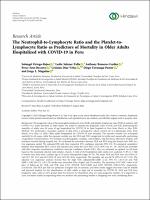The Neutrophil-to-Lymphocyte Ratio and the Platelet-to-Lymphocyte Ratio as Predictors of Mortality in Older Adults Hospitalized with COVID-19 in Peru
Related Resource(s)
https://www.hindawi.com/journals/dm/2022/2497202/Date
2022-08-03Author(s)
Ortega Rojas, Solangel
Salazar Talla, Leslie
Romero Cerdán, Anthony
Soto Becerra, Percy
Díaz Vélez, Cristian
Urrunaga Pastor, Diego
Maguiña, Jorge L.
Metadata
Show full item recordAbstract
Background. The prognostic value of the neutrophil-lymphocyte ratio (NLR) and platelet-lymphocyte ratio (PLR) in patients with COVID-19 is rarely described in older adults. We aimed to estimate the prognostic value of NLR and PLR, determining the mortality of adults over 60 years of age hospitalized for COVID-19 in three hospitals in Peru from March to May 2020. Methods. We performed a secondary analysis of data from a retrospective cohort carried out in Lambayeque, Peru, from March 18 to May 13, 2020. Older adults hospitalized for COVID-19 were included. The outcome variable was in-hospital mortality by all causes, while the exposure variable was the NLR and PLR (categorized in tertiles and numerically, performing a logarithmic transformation). We included sociodemographic variables, comorbidities, vital functions, laboratory markers, and treatment received during hospital stay. We evaluated the association between NLR and PLR using the hazard ratio (HR) in a Cox regression model. We estimated HR with their respective 95% confidence intervals (95% CI). We estimated cumulative/dynamic time-dependent ROC curves and reported area under the curve ROC (AUC-ROC) for 15-, 30-, and 60-day mortality with their respective simultaneous confidence intervals (confidence bands (CB)). Also, we estimated an optimal cut-off point based on the maximally selected rank statistics. Results. A total of 262 hospitalized older adults were analyzed, 71.8% () of whom were male with a median age of 70 years (interquartile range: 65-78). The mean NLR and PLR were 16.8 (95% CI: 14.9-18.7; SD: 15.5) and 50.3 (95% CI: 44.6-55.9; SD: 46.3), respectively. The mortality rate was 68.7% (95% CI: 62.7-74.3). The adjusted Cox regression analysis showed that the high NLR (; 95% CI: 1.43-3.14) and PLR (; 95% CI: 1.30-2.79) tertiles were associated with a higher risk of mortality. The maximum AUC-ROC values at 60 days of follow-up for NLR and PLR were 0.713 (95%CB: 0.627-0.800) and 0.697 (95%CB: 0.583-0.754), respectively. Conclusions. The NLR and PLR are predictors of higher risk of mortality, and these results suggest that both could be reliable and practical markers for the identification of older adults at high risk of mortality by COVID-19. NLR and PLR have prognostic value, with an AUC greater than 0.5; however, by themselves, they are weak prognostic markers. It is important to carry out future studies incorporating these two markers into preexisting models or designing new ones considering them.
Collections
- Publicados [4]






